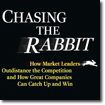
By Bob Clark
September 17, 2009
Chasing the Rabbit: How Market Leaders Outdistance the Competition and How Great Companies Can Catch Up and Win
 By Steven J. Spear
By Steven J. Spear
McGraw-Hill, New York, NY, Oct. 2008, 432 pages, $29.95
In many manufacturing endeavors it is common to examine and import the Toyota Production System to improve operations. The theory is that if it works for them, you can make it work in any organization. Steven Spear suggests a different view.
Just copying Toyota won’t work without major changes in the underlying systems and approaches. From his research he identifies four capabilities that must be put in place to become what he calls a high velocity organization. Those capabilities are as follows:
-¢ Regardless of size or complexity, don’t start a task until its design is specified and captures all the existing knowledge. Also, the design must include built-in tests to reveal problems.
-¢ Swarm and solve problems as they occur and where they happen without resorting to ad hoc workarounds. Develop real solutions based on new knowledge and rigorous experimentation.
-¢ When a new process approach is uncovered, it must be quickly moved throughout the organization.
-¢ A key leadership function in high velocity organizations is to develop everyone in the organization to be self-correcting, self-improving and self-innovating, fully participating in all that is done.
The most powerful aspect of this book is Spear’s focus on applying these four capabilities to every organization, not just manufacturing. He has crafted the book in a fashion that will prompt thoughtful executives in any endeavor to re-examine how they are leading their organizations. He offers leaders a different paradigm for organizing work than is found in much of the current literature - but it is one that will lead to real success and long-term growth.
In a recent interview, Spear said that these capabilities can only be achieved if senior leaders see “authentic discovery as a core process in operating their businesses.” In his view, “developing the business strategy is more a discovery process than a decision process.”
The strength of this book for anyone leading an organization is that it explores the tools needed to change the way one thinks about leading. The notion that the Toyota way is only applicable in manufacturing is set aside with clear examples. Especially enlightening was the health care delivery model examination.
In Spear’s framework, the “challenge to success in the marketplace today is moving quickly to identify needs, configure solutions that met the needs, and delivering those solutions.” This book will help any leader shift to a mindset that supports doing just that.
Bob Clark is the president of RWC Consulting LLC and has more than 30 years experience in labor-management relations. He provides consulting help in labor relations and is an adjunct professor at Concordia University in Ann Arbor, Mich.








